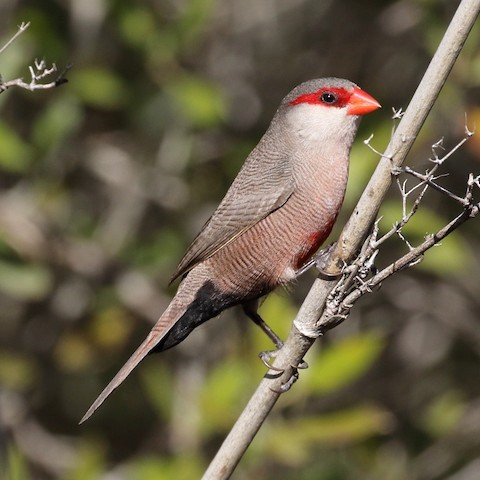Birdfinding.info ⇒ Locally common to abundant, and in many areas it is harder to avoid than to find. Within its natural range, it is especially numerous in the Lake Victoria region, eastern Zimbabwe, eastern South Africa, and Western Cape Province. Introduced populations have become extremely successful in coastal Portugal, many parts of eastern Brazil, Trinidad, Azores, Madeira, New Caledonia, and several other tropical oceanic islands. In Hawaii, it is abundant throughout Oahu and rapidly expanding in coastal lowlands of the Big Island, but less so on Kauai and Maui.
Common Waxbill
Estrilda astrild
Subsaharan Africa; widely introduced elsewhere. Inhabits humid grasslands and grassy brush and woodlands, where it favors tall, dense stands of grass and wetland margins. Adapts readily to human development, both rural and urban.
Natural Range. From Guinea and Mali east to Ethiopia and south to South Africa, but patchy in western and central Africa.
In western Africa, it occurs locally in southern Mali, Guinea, Sierra Leone, and Liberia—and historically also in several neighboring countries, but there are few recent reports—and separately from southeastern Nigeria and Cameroon southward mainly in coastal lowlands and more locally in the interior.
In eastern Africa, it is local in South Sudan and western and central Ethiopia (north approximately to the borders of southeastern Sudan and northern Eritrea), then becomes more widespread east and south of the Congo Rainforest from Uganda and central Kenya to the southern coast of Africa.
Introductions. Transplanted populations are well-established and generally increasing and expanding in many parts of the world: especially in eastern South America, the Iberian Peninsula, and numerous tropical islands.
On the Iberian Peninsula, originally introduced to Portugal, and has expanded nearly throughout that country and into several parts of Spain (coastal Galicia, the Extremadura, Andalucía, coastal Catalonia, and Mallorca).
Also established in much of Macaronesia: Azores (Ilha Terceira and São Miguel); Madeira (Funchal); the Canary Islands (mostly Gran Canaria, but also on Fuerteventura); and Cape Verde (mostly Santiago, but has appeared on several islands).
In eastern South America, it was originally introduced to São Paulo in the mid-1800s and has spread throughout the eastern lowlands of Brazil from Maranhão to Rio Grande do Sul, and in the interior to the Iguaçu area, eastern Goiás, and the Federal District, with isolated populations around several Amazonia cities (Rio Branco, Manaus, Macapá, and Belém) and locally elsewhere in Amazonas and Pará. Has likely expanded to adjacent parts of Bolivia, Paraguay, Argentina, and Uruguay, despite few records from those countries.
Populations are established on many islands worldwide: in the Caribbean, Martinique and Trinidad, with a few records from Tobago; in the South Atlantic, Ascension, St. Helena, São Tomé, Principe, and Bioko; in the Indian Ocean, the Seychelles, Mauritius, Réunion, and Rodrigues; and in the Pacific, Taiwan, Singapore, New Caledonia, Vanuatu (Efate), Tahiti, Moorea, Bora Bora, the Marquesas, and Hawaii (Oahu since the 1970s, then in the 1990s and early 2000s spread to Kauai, Maui, and the Big Island).
Identification
A small, slender, finely barred, pale, brown-and-gray finch with a vivid crimson mask, coral-red bill, and often a red blush on the lower belly.
The many subspecies vary in overall tone from relatively browner to grayer, and in underparts coloration, which can be mostly whitish, grayish, or brownish, often much paler (even immaculate white) on throat and chest, and can show any amount of red from a faint pinkish blush to extensive, vivid scarlet or crimson.
Readily confused with three closely related species: Black-rumped, Arabian, and Crimson-rumped Waxbills (see below for notes on distinguishing them).
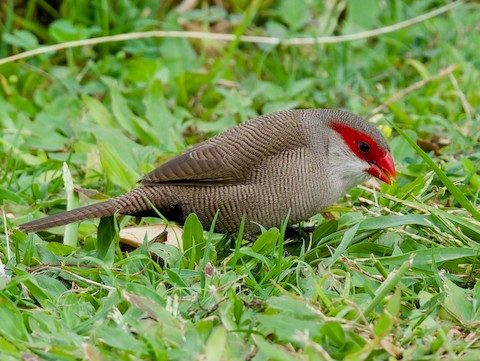
Common Waxbill, typical plumage, showing extensive barring above and below. (Kapiolani Park, Honolulu, Hawaii; May 5, 2018.) © Steven Hunter

Common Waxbill, with gray overall plumage and “dipped-in-ink” red mask. (Kapiolani Park, Honolulu, Hawaii; February 22, 2019.) © Nancy & Bill LaFramboise
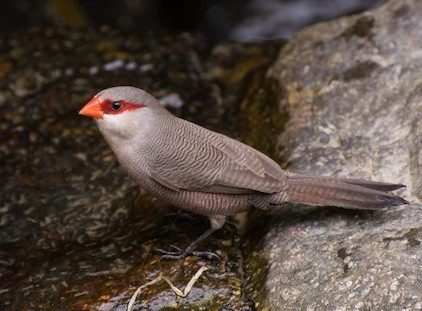
Common Waxbill, typical plumage. (Porto Belo, Santa Catarina, Brazil; January 23, 2016.) © Pablo Re

Common Waxbill, showing rosy blush on underparts and contrastingly white throat. (Sululta Plain West, Oromia, Ethiopia; November 9, 2018.) © Justin Goldberg

Common Waxbill, warm-brown and extensively barred overall with grayish crown and back. (Honolulu, Hawaii; July 13, 2016.) © Judy Matsuoka
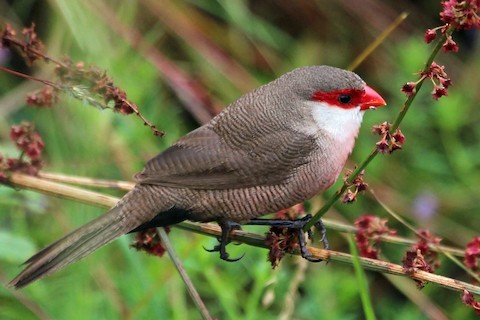
Common Waxbill, showing white throat and extensive barring above and below. (Sululta Plain West, Oromia, Ethiopia; November 9, 2018.) © Justin Goldberg

Common Waxbill, grayish-brown overall, showing extensive barring and small reddish patch on the beast. (Pouhala Marsh Wildlife Sanctuary, Waipahu, Oahu, Hawaii; March 14, 2020.) © Eric VanderWerf

Common Waxbill with generally grayish plumage, showing extensive barring above and below. (Kapiolani Park, Honolulu, Hawaii; October 23, 2019.) © Doug Hommert

Common Waxbill, with warm-brown plumage overall. (East Usambara, Tanga, Tanzania; April 25, 2015.) © Markus Lilje

Common Waxbill, mousy grayish-brown overall. (Honolulu, Hawaii; August 9, 2018.) © Mary Catherine Miguez

Common Waxbill, pale-gray overall. (Point Magnin, Noumea, New Caledonia; December 18, 2019.) © David Irving
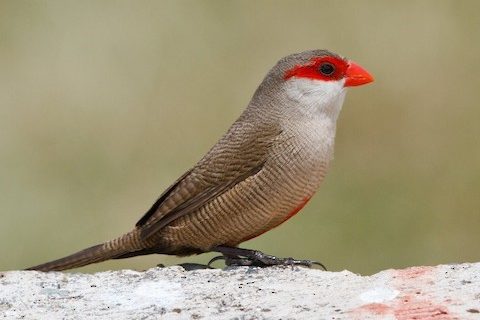
Common Waxbill, showing a brilliant red mask. (Keaiwa Heiau State Park, Aiea, Oahu, Hawaii; August 22, 2014.) © Jeff Stacey
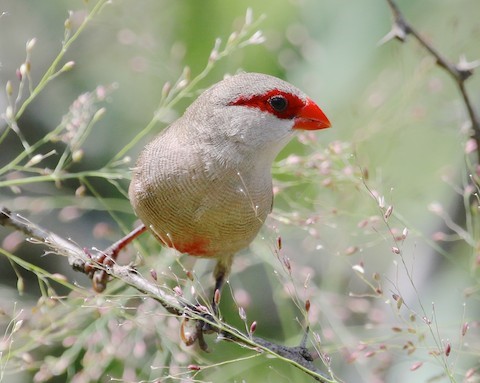
Common Waxbill, a pale variant with a deep crimson mask. (Mkhuze Game Reserve, Kwazulu-Natal, South Africa; January 20, 2017.) © Gil Ewing

Common Waxbill, showing extensive barring on upperparts and flanks. (Pamplemousses, Mauritius; March 3, 2009.) © Zoltan Kovacs
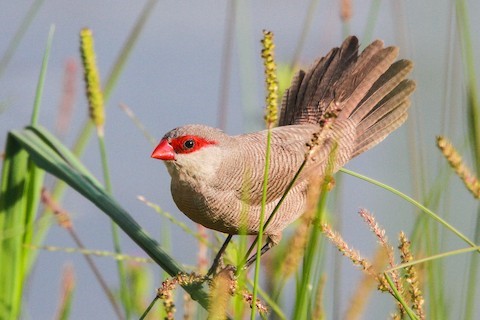
Common Waxbill, showing brown, barred tail. (Praça do Museu de Arte, Pampulha, Belo Horizonte, Minas Gerais, Brazil; October 7, 2018.) © Zé Edu Camargo

Common Waxbill, a variant that is warm-brown overall with dark underparts and a narrow red mask. (Afton Grove Marsh, Western Cape, South Africa; November 1, 2009.) © Jon Lowes

Common Waxbill, uniformly warm-brown overall. (Arahurahu Marae, Windward Islands, French Polynesia; September 19, 2013.) © Josep del Hoyo

Common Waxbill with generalized reddish blush on underparts and rump. (Parque do Tejo, Lisbon, Portugal; January 15, 2017.) © Vasco Valadares

Common Waxbill, brown overall with dark wings and tail. (Kranji Sanctuary Golf Course, Singapore; April 15, 2018.) © Fadzun A.
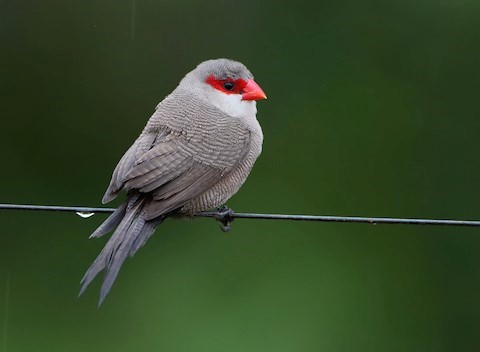
Common Waxbill, with grayish overall coloration. (Manaus, Amazonas, Brazil; February 23, 2018.) © Anselmo d’Affonseca
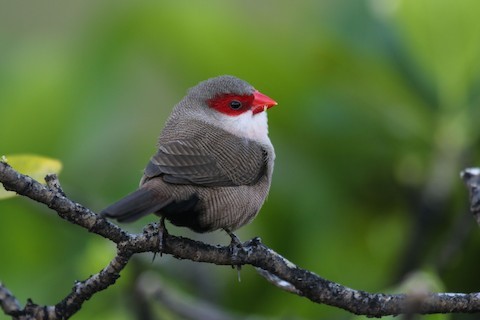
Common Waxbill, appearing extensively dark-gray above, with contrasting white throat. (Fort DeRyussy Beach Park, Honolulu, Hawaii; January 18, 2017.) © Gale VerHague

Common Waxbill, showing a generalized rosy blush on the underparts—note black vent. (Mogi das Cruzes, São Paulo, Brazil; September 20, 2018.) © Matthew Grube
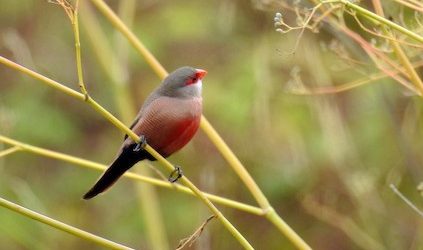
Common Waxbill, showing generalized rosy blush on the underparts, pale-gray crown, and black vent. (Parque da Paz, Almada, Setúbal, Portugal; January 13, 2016.) © Daniel Raposo
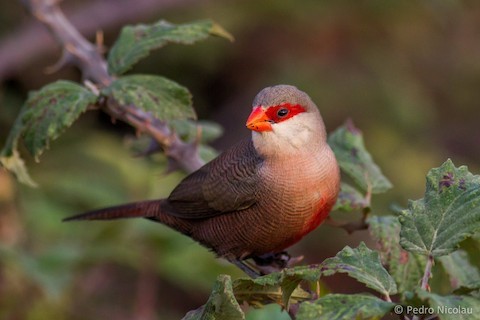
Common Waxbill with generalized rosy blush on the underparts and red central patch. (Ribeira do Almargem, Tavira, Faro, Portugal; August 28, 2013.) © Pedro Nicolau

Common Waxbill, showing reddish belly patch. (Polokwane Bird Sanctuary, Limpopo, South Africa; March 13, 2013.) © Dan Jones
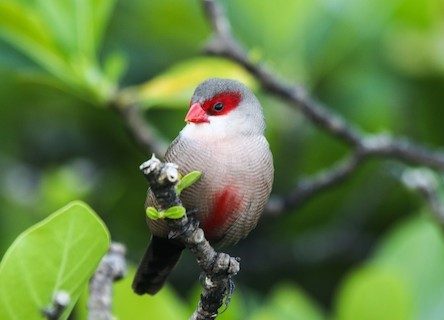
Common Waxbill, showing mostly whitish underparts with a central reddish belly patch. (Fort DeRyussy Beach Park, Honolulu, Hawaii; January 18, 2017.) © Gale VerHague

Common Waxbill, showing mostly white throat and chest. (Kapiolani Park, Honolulu, Hawaii; May 5, 2018.) © Steven Hunter

Common Waxbill with generalized rosy blush on underparts and red belly patch. (Ria de Alvor, Portimão, Faro, Portugal; October 9, 2019.) © Jaime Pires

Common Waxbill, showing atypically orange breast with reddish central patch. (Waimea Valley Audubon Center, Waialua, Oahu, Hawaii; September 13, 2018.) © Daniel Zittin

Common Waxbill with rosy breast and white cheeks. (Ribeira da Raia, Mora, Évora, Portugal; August 30, 2019.) © Jaime Pires

Common Waxbill, showing barred, gray crown and atypically orange breast with reddish central patch. (Kahaluu-Keauhou, Big Island, Hawaii; September 17, 2017.) © Veronica Heron
Immature plumage is like the adult’s, but with a reduced or absent red mask, and less pronounced barring. The bill is black, as in other immature waxbills.
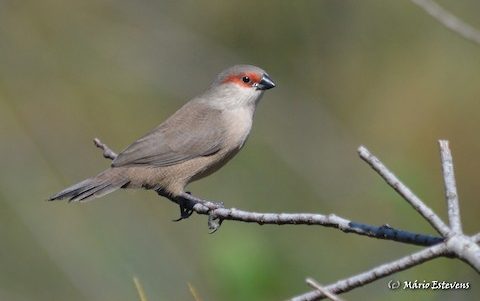
Common Waxbill, immature. (Jardim Urbano da Costa da Caparica, Almada, Setúbal, Portugal; October 15, 2015.) © Mário Estevens

Common Waxbill, immature with limited red mask. (Afton Grove Marsh, Western Cape, South Africa; November 1, 2009.) © Jon Lowes

Common Waxbill, immature. (Uluguru Nature Reserve, Morogoro, Tanzania; July 4, 2019.) © Charley Hesse TROPICAL BIRDING

Common Waxbill, immature. (Huétor-Tájar, Granada, Andalucía, Spain; October 21, 2019.) © David Hird
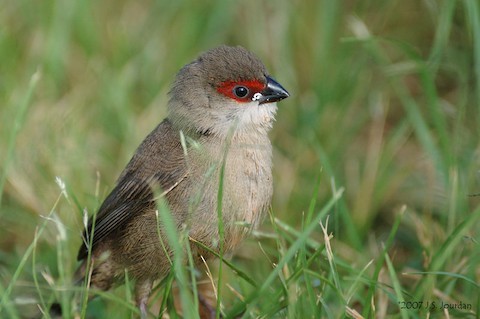
Common Waxbill, immature. (Pearl Harbor, Honolulu, Hawaii; November 16, 2007.) © Jerome Jourdon

Common Waxbill, immature. (Aiea Ridge Trail, Oahu, Hawaii; September 30, 2017.) © Sharif Uddin
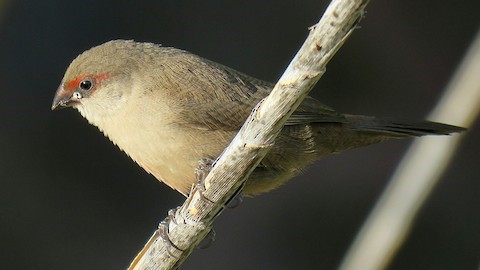
Common Waxbill, immature with warm-brown overall coloration and limited red mask. (Gran Canaria, Spain; December 10, 2017.) © Erkki Lehtovirta

Common Waxbill, immatures. (Machico, Funchal, Madeira, Portugal; August 9, 2011.) © Christoph Moning
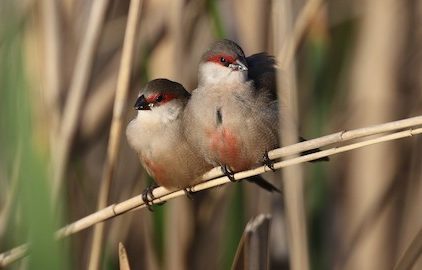
Common Waxbill, immatures. (El Prat de Llobregat, Barcelona, Cataluña, Spain; May 21, 2016.) © Daniel Jauvin
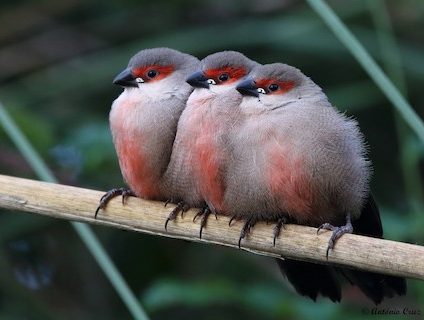
Common Waxbill, immatures with rosy central patches on the underparts. (Parque da Devesa, Vila Nova de Famalicão, Braga, Portugal; November 16, 2019.) © António Cruz
Cf. Black-rumped Waxbill. Common and Black-rumped Waxbills are very similar and occur together naturally across the Sahel, south to Tanzania, and through introductions elsewhere. Both have pale brownish-gray plumage overall, with a crimson mask, coral-red bill, and usually a pinkish blush on the underparts that is strongest on the lower belly. The potential for confusion is especially high because Common’s pattern and coloration are highly variable.
Overall Coloration: In general, Black-rumped is uniformly pale, whereas most Commons are not. Common varies significantly so there are many exceptions, but most Commons have darker upperparts and a contrastingly pale throat and chest. Also, most Commons have a vivid scarlet patch on the belly that extends onto the breast, whereas Black-rumped tends to show a subtle pinkish blush throughout the breast and belly, with a bright red patch that is limited to the lower belly.
Barring: Both species may show fine barring on both the upperparts and underparts, but Common’s barring is usually far more pronounced, obvious on the upperparts and noticeable the underparts. For Black-rumped, it requires a close look to discern any barring on the upperparts, and probably requires a handheld examination or an exceptionally clear photograph to discern any barring on the underparts.
Vent: Black-rumped has a pale, usually whitish vent, whereas Common’s vent is dark, usually blackish. This seems to be a universal, objective distinction between the species—diagnostic in all cases.
Tail: Black-rumped’s is unmarked black or dark brown with white outer edges. Common’s tail is brown and distinctly barred.
Immatures. Immature plumages also differ in that Common has a red mask—generally duller and less extensive than the adult’s—whereas immature Black-rumped’s face is mostly brown with a small blackish mask.
Cf. Arabian Waxbill. Common and Arabian Waxbills generally resemble one another but do not occur together naturally. However, Common Waxbill has been introduced so widely that it could occur almost anywhere in the world. Both have pale, brown-and-gray plumage overall, with a crimson mask, but differ in the usual color of the bill: coral-red on Common versus mostly blackish on Arabian. Immature Commons have black bills and red masks and would therefore be readily confused with Arabian.
The most reliable distinctions between Common and Arabian Waxbills are in the hindquarters. Arabian has an even-toned brown or blackish tail with white outer edges, and a pale vent (thus resembling Black-rumped), whereas Common’s tail is heavily barred and its vent is dark. These differences hold true for both adults and immatures.
In most cases, Common can also be distinguished by its more heavily barred upperparts, more extensively barred upperparts, and a red or rosy patch on the belly. Arabian is faintly barred, but still noticeably so, on the upperparts and the sides—so there is some potential for overlap in this feature.
Cf. Crimson-rumped Waxbill. Common and Crimson-rumped Waxbills are generally similar and occur together naturally across much of eastern Africa and through introductions elsewhere. Both have pale, brown-and-gray plumage overall, with a crimson mask and some amount of pink or red on the belly.
In most cases, they differ conspicuously in bill and upperparts coloration: Adult Crimson-rumped has a black bill, an unmarked red rump, and varying amounts of red in the wings, whereas adult Common has a coral-red bill and barred, brown rump and wings. Some Commons show a reddish flush on the rump and wings, but rarely if ever the vivid red tones of Crimson-rumped.
Immature Crimson-rumped typically has a small blackish mask, which differentiates it from Commons of all ages. Immature Commons have black bills and red masks but are plainer brown overall than adults of either species.
In all plumages, the vent color is diagnostic: blackish on Common versus pale brown (and often slightly reddish) on Crimson-rumped.
Notes
Polytypic species consisting of fifteen recognized subspecies.
References
BirdLife International. 2018. Estrilda astrild. The IUCN Red List of Threatened Species 2018: e.T22719574A131995211. https://dx.doi.org/10.2305/IUCN.UK.2018-2.RLTS.T22719574A131995211.en. (Accessed April 2, 2020.)
Brazil, M. 2009. Birds of East Asia. Princeton University Press, Princeton, N.J.
Clement, P., A. Harris, and J. Davis. 1993. Finches and Sparrows: An Identification Guide. Princeton University Press, Princeton, N.J.
eBird. 2020. eBird: An online database of bird distribution and abundance. Cornell Lab of Ornithology, Ithaca, N.Y. http://www.ebird.org. (Accessed April 2, 2020.)
Garcia-del-Rey, E. 2011. Field Guide to the Birds of Macaronesia: Azores, Madeira, Canary Islands, Cape Verde. Lynx Editions, Barcelona.
Garcia-del-Rey, E. 2018. Birds of the Canary Islands. Christopher Helm, London.
Hawaii Audubon Society. 2005. Hawaii’s Birds (Sixth Edition). Island Heritage Publishing, Waipahu, Hawaii.
Kirwan, G.M., A. Levesque, M. Oberle, and C.J. Sharpe. 2019. Birds of the West Indies. Lynx Edicions, Barcelona.
Mullarney, K., L. Svensson, D. Zetterström, and P.J. Grant. 1999. Birds of Europe. Princeton University Press, Princeton, N.J.
Payne, R., and G.M. Kirwan. 2020. Common Waxbill (Estrilda astrild). In: del Hoyo, J., Elliott, A., Sargatal, J., Christie, D.A. & de Juana, E. (eds.). Handbook of the Birds of the World Alive. Lynx Edicions, Barcelona. https://www.hbw.com/node/61115. (Accessed April 2, 2020.)
Pyle, R.L., and P. Pyle. 2017. The Birds of the Hawaiian Islands: Occurrence, History, Distribution, and Status. Version 2 (January 1, 2017). http://hbs.bishopmuseum.org/birds/rlp-monograph/. B.P. Bishop Museum, Honolulu, Hawaii.
Raffaele, H., J. Wiley, O. Garrido, A. Keith, and J. Raffaele. 1998. A Guide to the Birds of the West Indies. Princeton University Press, Princeton, N.J.
Sinclair, I., P. Hockey, W. Tarboton, and P. Ryan. 2011. Birds of Southern Africa (Fourth Edition). Random House Struik (Pty) Ltd. Cape Town, South Africa.
van Perlo, B. 1999. Birds of Southern Africa. Princeton University Press, Princeton, N.J.
van Perlo, B. 2002. Birds of Western and Central Africa. Princeton University Press, Princeton, N.J.
van Perlo, B. 2009. A Field Guide to the Birds of Brazil. Oxford University Press, Oxford.
WikiAves, Bico-de-lacre, https://www.wikiaves.com.br/wiki/bico-de-lacre. (Accessed April 3, 2020.)
Xeno-Canto. 2020. Common Waxbill – Estrilda astrild. https://www.xeno-canto.org/species/Estrilda-astrild. (Accessed April 2, 2020.)
